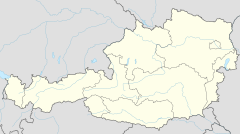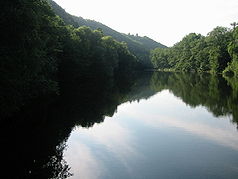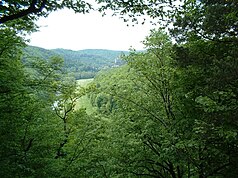Thayatal National Park
| Thayatal National Park | ||
|---|---|---|
|
|
||
| Location: | Lower Austria , Austria | |
| Surface: | 13.3 km² | |
| Founding: | 2000 | |
| National park map | ||
The 13.3 km² National Park Thayatal is located in the Lower Austrian border area with the Czech Republic and connects to the Czech Národní park Podyjí . The Thayatal with its steep hillside forests is one of the most beautiful breakthrough valleys in Austria . The highest point is the gneiss mountain around which the Thaya flows .
The basis for the national park is the Lower Austrian National Park Act. It was agreed between the republic and the federal state back in 1997. It is largely based on the international criteria for national parks published by the IUCN , the International Union for Conservation of Nature . The Thayatal is referred to as a Category II area. An enlargement to 1.7 km² was already planned when it was founded.
250 ha of the core zone of the national park belong to the WILDForest areas certified by the European Wilderness Society , 2 km of the Thaya are also certified as WILDRiver .
location
In addition to the town of Hardegg, the Hardegg Castle and the Kaja ruins are located in the national park . In Hardegg , you can walk directly from the Austrian part over the Thaya bridge , which forms the national border, into the Czech National Park or go by bike .
In addition to the orientation towards the sun, the shape of the valley and the chemical properties of the underground rock are also responsible for the ecological diversity.
Emergence
Although the national park is much older on the Czech side, efforts to obtain protection go back a long way in Austria.
After it became known in 1984 that a power plant was to be built on the Czech side on the Thaya, citizens' initiatives and the city of Hardegg tried successfully to prevent this.
In 1988 and 1991 two areas along the Thaya are placed under nature protection by ordinance of the Lower Austrian state government. These two areas are the forerunners of today's national park.
After the National Park was created in the Czech Republic in 1991, it was decided in 1992 in Austria to draw level with the protection status.
After the preparation of the various feasibility studies and the creation of the legal framework, the state contract between Ministers Bartenstein and Edlinger for the Republic and Governor Pröll for the state of Lower Austria for the establishment of the national park was signed in 1997 .
flora
The smallest national park is home to half of all plant species found in Austria . The reason is that the area lies on the climatic boundary between the rougher, more humid plateau climate of the Central European transitional climate in the Waldviertel and the continentally influenced Pannonian climate in the Weinviertel. In the western part and on the shady northern slopes, beech forest communities dominate , in which not only the red beech but also sycamore , yew and sycamore elm can be seen. In the herb layer growing Turk's cap , daphne , sorrel , onion Toothwort , melica uniflora and as a special feature, the White Waldvögelein .
Especially in the eastern part of the area, oak and hornbeam forests can be found on the south-facing slopes , which are very dry and warm due to solar radiation . The larva of the stag beetle grows in the fallen trees . The rare steppe polecat migrates through the larger dry and warm oak forests of the Czech National Park .
fauna
Numerous rare animal and plant species were able to defend their habitat in the Thayatal: otters , dice snakes , crested newts and white-tailed eagles as winter guests benefit from the intact river ecosystem . Black stork , Aesculapian snake and white-backed woodpecker live hidden in the near-natural forest. The dry grassland and rocky sites are also an important habitat for endangered species such as the eastern green lizard , smooth snake , eagle owl and common raven . After the opening of the Iron Curtain , animal species that had already disappeared in Austria were spotted again in the Thayatal: the elk and the wildcat .
Filmography
- The valley at the border: Thayatal National Park , documentary film, 50 min., Austria, 2000, production: Lotus Film, script and director: Heinz Leger
- In the realm of the wildcat: 10 years of the Thayatal National Park , documentary, 23 min., Austria, 2009, production: ORF-Landesstudio Niederösterreich, director: Sabine Daxberger
Individual evidence
- ^ "Quiet" beginning of the Thayatal National Park on January 1, 2000 on APA of December 28, 1999, accessed on March 16, 2010.
- ↑ Nick Huisman, European Wilderness Network: Thayatal WILDForest , 23 August 2018.
- ↑ Nick Huisman, European Wilderness Network: Thaya WILDRiver , 23 August 2018.
literature
- Hans Matz: The Thaya - A natural and cultural area in the Waldviertel .
- Thomas Hofmann: Thayatal-Podyjí National Park - nature connects .







